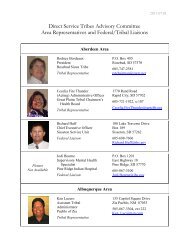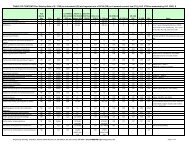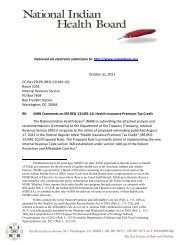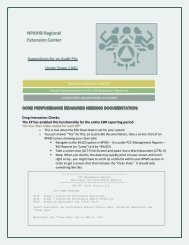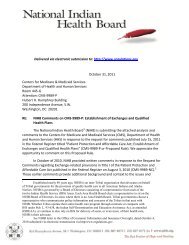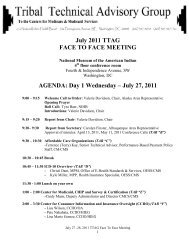mmpc - National Indian Health Board
mmpc - National Indian Health Board
mmpc - National Indian Health Board
Create successful ePaper yourself
Turn your PDF publications into a flip-book with our unique Google optimized e-Paper software.
An American <strong>Indian</strong> child that may not have enough blood quantum to be enrolled in a Tribe will be<br />
considered <strong>Indian</strong> under Medicaid. But not in Exchanges, because she lacks enough blood quantum to<br />
be enrolled in either of her parent’s tribe.<br />
An American <strong>Indian</strong> cannot enroll in his father’s tribe where tribal membership is passed from mother<br />
to child in what has been called matrilineal descent, and therefore he would not be considered AI/AN<br />
under Exchanges, even though he would qualify as AI/AN in Medicaid.<br />
An individual who has been determined to be AI/AN by the federal Bureau of <strong>Indian</strong> Affairs and has a<br />
Certificate of <strong>Indian</strong> Blood issued by that federal agency that is recognized by every other federal<br />
agency, is not recognized as <strong>Indian</strong> by the Federally-facilitated Exchange or state-based exchanges.<br />
A person enrolled in Medicaid as an AI/AN no longer meets the income criteria and does not purchase<br />
health insurance because she gets her care from her Tribal health clinic and assumes that she is<br />
exempt from tax penalties because she is AI/AN. However, IRS uses a different definition of AI/AN<br />
than Medicaid uses, and she finds out later that she does have to pay a tax penalty.<br />
The complications of Exchanges to administer and families to understand the varying definition of<br />
<strong>Indian</strong> and the high level of churning that is anticipated for AI/AN families will disenfranchise AI/AN<br />
families from participating in opportunities provided under the Affordable Care Act.<br />
In each of these cases, the individuals could be living in a family that is considered AI/AN, in an AI/AN<br />
community – perhaps even on a reservation, attending <strong>Indian</strong> schools funded by the federal government, and<br />
receiving their health services at an <strong>Indian</strong> <strong>Health</strong> Service clinic or hospital. They could be considered AI/AN<br />
for Medicaid, CHIP and every federal <strong>Indian</strong> program. And, still they would not be qualified for the special<br />
protections for AI/AN in <strong>Health</strong> Insurance Exchanges according to the current interpretation of ACA by the<br />
Department of <strong>Health</strong> and Human Services.<br />
As a result of the differences in how Exchange rules are being written and how Medicaid and CHIP rules are<br />
written, it is not possible to have a simple, streamlined application that relies on existing electronic data<br />
sources. The application must ask at least three different questions to determine who qualifies as <strong>Indian</strong><br />
under the different programs. Those three questions take up a lot of space on an application which will be<br />
used by a lot of people who are not AI/AN, and they will confuse a lot of people who are AI/AN. If Exchanges<br />
use the same definition as Medicaid, CHIP and the <strong>Indian</strong> <strong>Health</strong> Service, they could use the electronic<br />
registration data base from the IHS as part of the application process. However, the more restrictive<br />
definition currently in use by Exchanges may require someone at every Exchange and at every Tribal<br />
government site to process paperwork that shows that an individual has a tribal enrollment card. Ironically,<br />
the ACA calls for self-attestation for almost every aspect of the application (except citizenship), and yet AI/ANs<br />
may be expected to provide documentation instead of using self-attestation to prove that they are a member<br />
of a Tribe or Alaska Native regional or village corporation. The Administration should be trying to make it<br />
easier for underserved individuals to enroll in health insurance through Exchanges, not more difficult.<br />
Operationally, it is going to be a nightmare to have different definitions of AI/AN for Medicaid, CHIP and<br />
Exchanges. Personnel at call centers, navigators, in-person assisters, and individuals working in <strong>Indian</strong> health<br />
clinics will have to explain to people why they are considered an <strong>Indian</strong> for one federally-funded program, but<br />
not for another. Explaining the benefits of this new program will be difficult enough. As health care providers<br />
bill Medicaid Plans and Qualified <strong>Health</strong> Plans, they will need to know whether cost sharing waivers apply for<br />
some AI/AN and not for others.




